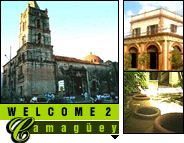 The province of Camaguey is located in central Cuba. The capital city of the province is also called CamagŁey.
The area is a gigantic prairie and is Cuba's largest province by size but not population. The major economic activities are cattle rearing (practiced here since the early colonial period), the cultivation of sugarcane, and the production of chromites. Meatpacking, pineapple canning, and other agricultural processing are also major industries in Camaguey.
CamagŁey, city is the island's third most populous city, CamagŁey, is a leading hub of rail, road, and air transport as well as an important commercial nerve center for the island of Cuba. The economy is based essentially on agriculture, and mining. Industries (mainly meatpacking and dairy processing) are typically related to dispensation and transport. Founded in 1514 as Santa Maria del Puerto Principe, the city was moved to its present site in 1528 and renamed after the Native American village that previously occupied that site. During the colonial period CamagŁey produced salted beef for the Spanish fleets and was often pillaged by English, French, and Dutch pirates. Camaguey, which has retained much of its Spanish colonial atmosphere, is noted for its churches, mansions, and narrow twisting streets.
|